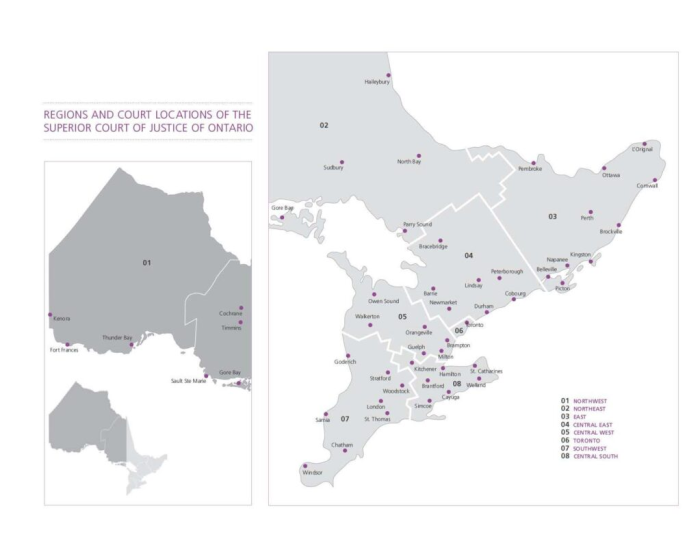
Practice Directions and Notices
What are Practice Directions?
Practice Directions are a set of rules that detail court procedures for court cases. The family practice directions supplement the Family Law Rules. These directions cover everything from how you submit documents to the court to the etiquette expected during hearings. Practice directions have been designed to ensure consistency, fairness, and efficiency in court proceedings. They provide detailed instructions on various matters such as case management, disclosure requirements, trial preparation, and even alternative dispute resolution processes like mediation.
What are the types of practice directions?
There are provincial, regional and courthouse specific practice directions. A provincial practice direction applies across all regions in Ontario and covers general procedures for family law cases. Regional practice directions are specific to particular regions and detail local practices or requirements. Courthouse specific practice directions apply to that one courthouse.
What is the consolidated Provincial Practice Direction for Family Proceedings at the Superior Court of Justice?
The “Consolidated Provincial Practice Direction for Family Proceedings at the Superior Court of Justice” is a comprehensive set of procedural guidelines that apply to all family court proceedings within the Ontario Superior Court of Justice. This practice direction is designed to streamline and standardize the handling of family law cases across the province, ensuring consistency in practice and helping to clarify procedural expectations for parties, lawyers, and the judiciary.
What does it cover?
The “Consolidated Provincial Practice Direction for Family Proceedings at the Superior Court of Justice” covers a wide range of procedural and administrative guidelines intended to streamline and standardize family law proceedings across Ontario. Some of the topics it covers include:
- Filing Materials Electronically: Guidelines for electronically filing court documents, including the use of the Justice Services Online (JSO) platform and CaseLines for managing documents during court proceedings.
- Document Standards: Standards for document naming, filing, and presentation, including specific formats and protocols for submitting materials to ensure consistency and ease of access during judicial reviews.
- Court Fees and Payments: Information on court fees associated with filing documents and how these fees can be paid electronically through the JSO platform or at the court.
- Financial Disclosure: Rules and expectations for the disclosure of financial information by parties involved in family law cases, aimed at ensuring transparency and fairness in matters related to support and property division.
- Conferences: Detailed procedures for different types of conferences, including case conferences, settlement conferences, and trial management conferences, with guidelines on how to prepare and what documents to file.
- Motions: Instructions on how to handle short and long motions, including requirements for filing materials, restrictions on document length, and guidelines for presenting arguments effectively.
- Dispute Resolution: Emphasis on using alternative dispute resolution methods to settle disputes outside of court. This includes the roles and responsibilities of Dispute Resolution Officers (DROs) and the use of mediation.
- Privacy and Access to Court Files: Rules governing the privacy of court documents and the circumstances under which the public and other parties can access these files.
- Courtroom Etiquette and Procedure: Guidelines on courtroom behavior, including gowning requirements for counsel and the use of electronic devices in the courtroom.
- Adjournments and Scheduling: Policies regarding the scheduling of court appearances and the conditions under which cases may be adjourned.
- Use of Technology in Hearings: Procedures for virtual hearings and the use of electronic communication tools to facilitate court proceedings.
- Support Resources: Information on additional support available to litigants, such as family court support workers for victims of domestic violence and legal advice resources.
What are regional practice directions?
Regional practice directions are tailored procedural guidelines specific to judicial regions, designed to address the unique administrative, procedural, and logistical needs within different areas. These guidelines adapt general court rules to accommodate local practices, resource allocations, and specialized courts such as drug courts or domestic violence courts. They also outline coordination with local law enforcement and community resources, vary public access and media coverage rules, and manage pilot projects testing new judicial procedures or technologies. Particularly in family law proceedings, regional practice directions consider local family dynamics, economic conditions, and available community support, ensuring the justice system is responsive and effective while maintaining consistency with broader provincial or national laws.
What is “Court Notice Finder” website?
Court Notice Finder is a website run by volunteers who are Ontario family law legal professionals. They go through the voluminous court notices and organize them. You can look up the notices for a particular region on their website.

Map of the 8 Court Regions of Ontario. Source: Ontario Courts, https://www.ontariocourts.ca/scj/contacting-the-court/court-location
Links for Regional Practice Direction and Notices
Link: https://www.ontariocourts.ca/scj/practice/regional-practice-directions/toronto/
London, Chatham, Goderich, St. Thomas, Sarnia, Stratford, Windsor, Woodstock
Link: https://www.ontariocourts.ca/scj/practice/practice-directions/southwest/
Belleville, Brockville, Cornwall, Kingston, L’Original, Napanee, Ottawa, Pembroke, Perth, Piction
Link: https://www.ontariocourts.ca/scj/practice/practice-directions/east/
Thunder Bay, Fort Frances, Kenora
Link: https://www.ontariocourts.ca/scj/practice/practice-directions/northwest/
Northeast Region, Ontario
Cochrane, Gore Bay, Haileybury, North Bay, Parry Sound, Sault Ste. Marie, Sudbury, Timmins
Link: https://www.ontariocourts.ca/scj/practice/regional-practice-directions/northeast/
Central West Region, Ontario
Brampton, Guelph, Milton, Orangeville, Owen Sound, Walkerton
Link: https://www.ontariocourts.ca/scj/practice/practice-directions/central-west/
Central South Region, Ontario
Hamilton, Brantford, Cayuga, Kitchener, St. Catharines, Simcoe, Welland
Link: https://www.ontariocourts.ca/scj/practice/regional-practice-directions/central-south/
Central East Region, Ontario
Newmarket, Barrie, Bracebridge, Cobourg, Lindsay, Oshawa, Peterborough
Link: https://www.ontariocourts.ca/scj/practice/regional-practice-directions/central-east/
